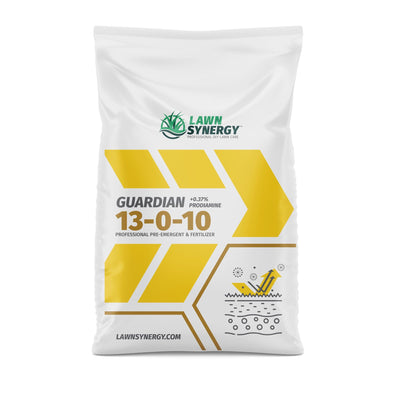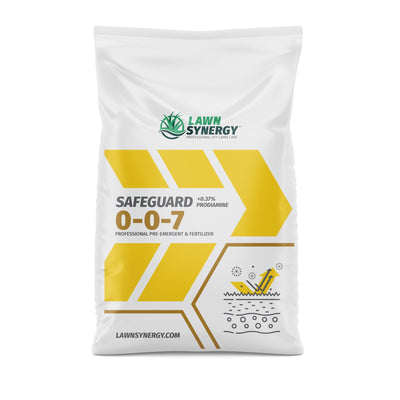For homeowners who take lawn care seriously, nothing's more frustrating than fighting weeds after they've already taken hold. That's where pre-emergent herbicides come in. Used correctly, these products stop weeds before they even break the surface.
But with so many options, and plenty of underperformers on the market, it's fair to ask: What is a good pre-emergent?
Let's break down what makes a pre-emergent effective, how and when to apply it, which products professionals trust, and how to avoid the common missteps that lead to disappointing results.
What this article covers:
- Why Pre-Emergents Are the Foundation of Good Weed Control
- Choosing the Right Product for Your Lawn
- When and How to Apply for Best Results
- Best Pre-Emergents for DIY Homeowners
- Common Mistakes and How to Avoid Them
- Frequently Asked Questions
Why Pre-Emergents Are the Foundation of Good Weed Control
A strong lawn starts with strong prevention. Pre-emergent herbicides are not weed killers. Rather, they're seed germination blockers.
When applied at the right time, they create a chemical barrier in the soil that disrupts weed seeds before they sprout. This helps protect your turf from annual invaders such as crabgrass, Poa annua, goosegrass, spurge, and other common nuisances.
A good pre-emergent:
- Has long soil residual (lasting 8 to 12 weeks or more)
- Targets the specific weed seeds you're trying to stop
- Pairs well with fertilizers to boost lawn growth while blocking weeds
- Works with your grass type (cool- or warm-season)
- It is timed to your climate and lawn care schedule
Professional estate managers rely on pre-emergents as the first line of defense in any lawn care plan. For DIYers, it's one of the best ways to elevate your results.

Choosing the Right Product for Your Lawn
No single pre-emergent is perfect for every yard. The best choice depends on your grass type, regional climate, and the specific seasonal challenges you face.
Know Your Grass and Target Weeds
Warm-season lawns like Bermuda, Zoysia, and St. Augustine benefit from spring and fall applications to combat crabgrass and annual bluegrass.
Cool-season lawns (like tall fescue and Kentucky bluegrass) need well-timed pre-emergents to block summer weeds without damaging tender roots.
If you're planning to seed in the next few weeks, you'll want to avoid most pre-emergents, as they block all seeds, weeds, and grass alike. In that case, time your applications carefully, or use specialized options like Lawn Synergy's starter fertilizers after the lawn establishes.
Look for Fertilizer-Enhanced Formulas
Products like Guardian 13-0-10 combine trusted weed prevention with potassium and nitrogen for healthy spring green-up. Guardian uses pro-grade barricade chemistry (prodiamine) with estate-level nutrition — no filler, no fluff.
Another effective option is Safeguard 0-0-7, which delivers pre-emergent protection without added nitrogen. It's the ideal choice if you're pairing it with a separate nitrogen fertilizer like Almighty 20-0-10 for a stronger push.
When and How to Apply for Best Results
Timing is everything with pre-emergents.
Apply too early and you risk product breakdown before weeds emerge. Apply too late, and you've missed your chance.

The Right Pre-Emergent Schedule
Weed seeds germinate based on soil temperature, not the date on the calendar. Timing is everything.
- Spring (February to April): Target crabgrass and other summer annuals. Apply once the soil temperature reaches and remains consistent at 55°F for several days. We go in depth in our guide on how to apply pre-emergent in spring.
- Fall (August to October): Stop poa annua, chickweed, and henbit before they sprout. Apply when daytime temps begin dropping into the 70s.
Use a soil thermometer or your local extension's online tracker to time your applications accurately. In warmer regions like Florida and the Carolinas, a second spring application may be needed to extend coverage through the season.
How to Apply Pre-Emergent in Spring
Start by mowing and lightly watering your lawn 24 to 48 hours beforehand. Then use a broadcast spreader to apply a granular product, such as Guardian 13-0-10, which distributes evenly and stays in place.
Water it in with about 0.25 to 0.5 inches of irrigation or rainfall within three days. This activates the barrier in the topsoil layer.
After application, avoid raking, aerating, or disturbing the soil. These actions can break the protective seal and reduce effectiveness.
You can fertilize after applying pre-emergent (especially if you're using a product without added nitrogen), but wait at least two weeks before seeding any new grass.
Otherwise, your grass seed will get blocked just like the weeds. For more info, check out this guide for the best pre-emergent schedule.

Best Pre-Emergents for DIY Homeowners
If you're looking for real, professional-grade results without the price tag of a lawn care service, these are your go-to products:
Guardian 13-0-10
One of the best all-around options is Guardian 13-0-10, a prodiamine-based pre-emergent (the same active ingredient found in Barricade) trusted by turf managers across the country.
It's ideal for use on both spring and fall lawns, whether warm- or cool-season, and includes potassium to promote strong root development.
This product offers broad-spectrum protection and a clean, even application, perfect for DIY enthusiasts who want professional-level performance.
Safeguard 0-0-7
For a lower-nitrogen approach, Safeguard 0-0-7 delivers the same reliable pre-emergent protection using prodiamine, but without the added nitrogen.
That makes it an excellent choice for midseason follow-ups or for use during heat stress, when you want to block weeds without pushing excess growth.
It's a smart fit for lawns that are already well-fed or being managed with separate nutrient applications.
Both options outperform, with higher-quality nutrients and precision dosing.
Common Mistakes and How to Avoid Them
Even with the right product, results can fall short if you misapply it.
Here's how to dodge the most common pitfalls:
- Applying too early or too late: Always use soil temperature, not calendar dates, as your guide
- Skipping water-in: Pre-emergents need moisture to activate because granules won't form a barrier if left dry
- Overseeding too soon: Wait at least 8 to 12 weeks after pre-emergent before seeding
- Using the wrong rate: Follow the bag instructions by lawn size, not by guesswork
- Layering products improperly: Be careful when combining weed and feed routines — know when to apply weed and feed after pre-emergent
Avoid these missteps and you'll stay well ahead of weed season.

Frequently Asked Questions
Can I seed after applying pre-emergent?
No. Pre-emergents block all seeds, including grass. Wait 8 to 12 weeks before seeding or choose a starter fertilizer that's safe for new lawns.
Will pre-emergents kill existing weeds?
No, these products only prevent germination. If weeds are already growing, use a post-emergent herbicide first, then follow with a pre-emergent to stop future outbreaks.
How long does one application last?
Most prodiamine-based pre-emergents last 10 to 12 weeks. In warmer climates with long growing seasons, a second application may be needed in late spring or early summer.
Conclusion
Knowing what a good pre-emergent is means understanding your lawn's needs, the optimal seasonal timing, and the product's performance.
At Lawn Synergy, we've taken the guesswork out by offering pro-grade solutions like Guardian 13-0-10 and Safeguard 0-0-7, backed by expert advice and real estate-care experience.
Want help mapping out your pre-emergent plan? Reach out to Lawn Synergy or browse our full lineup of professional-grade fertilizers and seeds.
Ready to learn more about lawn care? Check out these articles:



